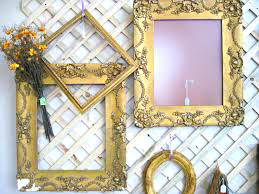
Curious Boys Photo
TREASURES IN THE ATTIC

Curious Boys Photo
The page sounds like a hokey ad from
Antiques Weekly; but, it isn't about your
standard type of antique. I was rumbling around in my attic, searching one of my
old White Owl Miniatures cigar boxes in which to ship something when I ran
across a number of photos in one of the boxes. I know these were photos I had
originally deemed unfit for the site [mostly due to poor quality or horrible
centering]. I'm not so dismissive with racing photos now, because the importance
of their content may outweight their artisitic value.
I will take each of the shots that can at least be recognized and add some
background story to go along with them. This is a nice find and a fun page to
do. I hope you enjoy it. As usual, if I get stuff wrong or if yoou have
info to add, please let me know.
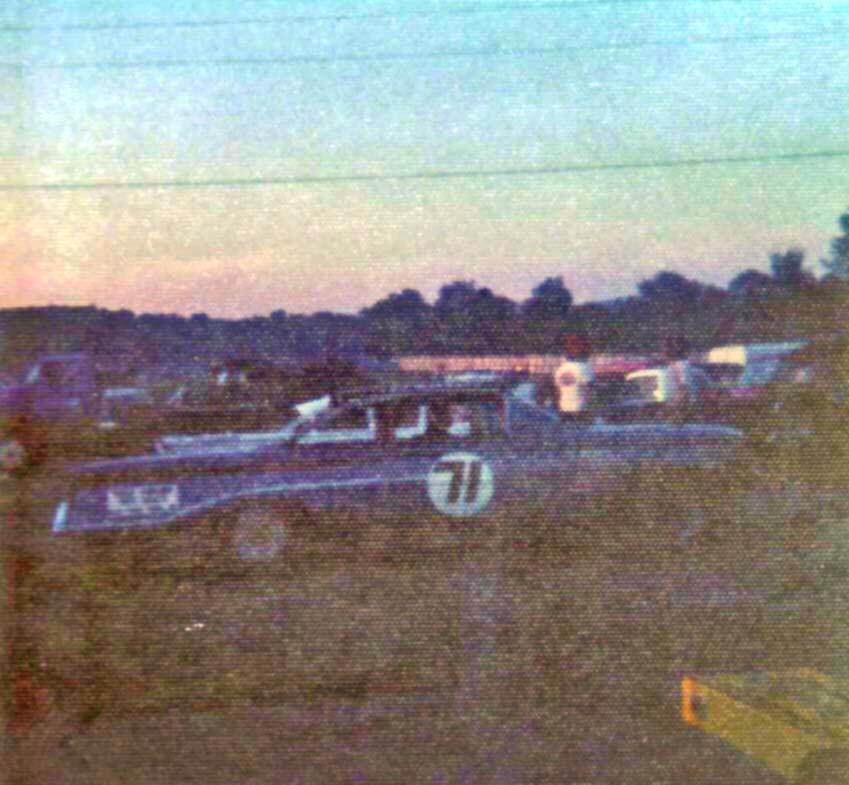
Ladabouche Photo [in damned poor light]
Al Maynard's Hurricane
Division Olds sits in the Catamount pit area, around 1971, around twilight.
Besides the above Oldsmobile, Maynard would build two other cars - one Chevy which he ran himself, and another that White would drive after his own car was apparently no longer operable. White would be remembered as one of the better Hurricane drivers of the early years despite not beginning his career until age 50. Between the two, they would inspired two younger Maynards, Adam and Aaron of Milton, to race their own cars in the early 2000's. Aaron would go on to become the ACT announcer while Adam, a former student of mine, served in the military. Al Maynard really started something with that Olds.
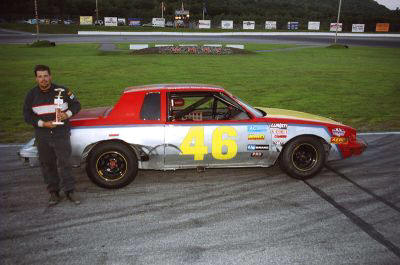
Ladabouche Collection
Aaron Maynard wins one at Airborne around
2005. Sorry, Adam, I don't have a shot of you yet.
_____________________________________________________________________________________________________________________________________
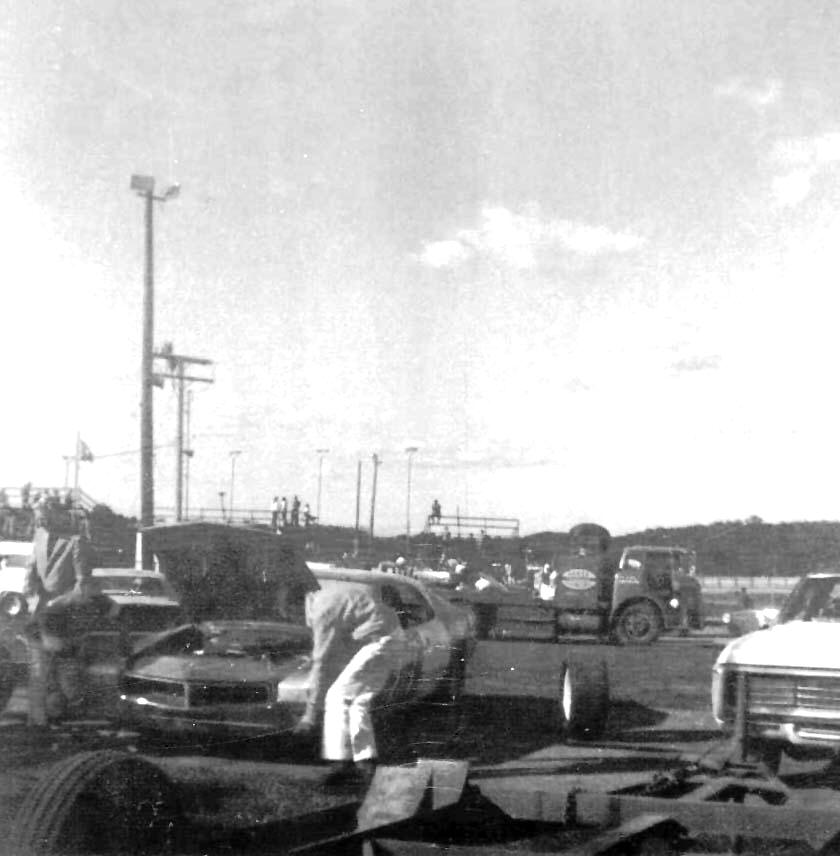
Ladabouche Photo [in damned poor light]
The Huggins Javelin - likely
driven by Jim Paschal - sits in the pits at Catamount around
1970 as the NASCAR Grand Touring Division ran its first of two races there.
The NASCAR class called The Grand Touring Division was barely a year or two old when it booked a race at Catamount Stadium, in conjunction with a Northern tour of sorts much like its Grand National senior division used to do a few years before. Not yet very popular or well - known [perhaps due its rather un - NASCAR - like name], the class featured "pony cars" like the Camaro, the Mustang, the Javelin, the Barracuda, and the Cougar. To add to its odd beginning, it even had races where foreign cars were included: that was a no - no with most ultra - conservative NASCAR fans.
Just like its senior division, it didn't take long before the big money teams and the Grand National drivers who got the best equipment were dominating the shows. One of the first bigger money teams was the Huggins Javelin team, which featured Jim Paschal, a veteran who was shading towards the end of his Grand National career. Many of the Grand Touring teams showed up with very modest haulers; some even had open trailers. Huggins had the big cube van and the crew to go with it. Catamount would get [for the first time] to see Timy Lund, Paschal, and a few other name drivers to go along with the Frank Sesssom's, the Brewers, and the other lesser - knowns who populated the GT division.
Catamount's free - spending former owner, Jack DuBrul, would a Javelin of his own for the race while Catamount regular Tom Tiller drove a car for old friend Stan Starr, Sr. The GT/Grand American races were held for two years only at the Milton track. Later, the track would turns its thundering automatic tranny Hurricanes into a 6 cylinder, pony car Grand Amrerican division of its own.
_____________________________________________________________________________________________________________________________________
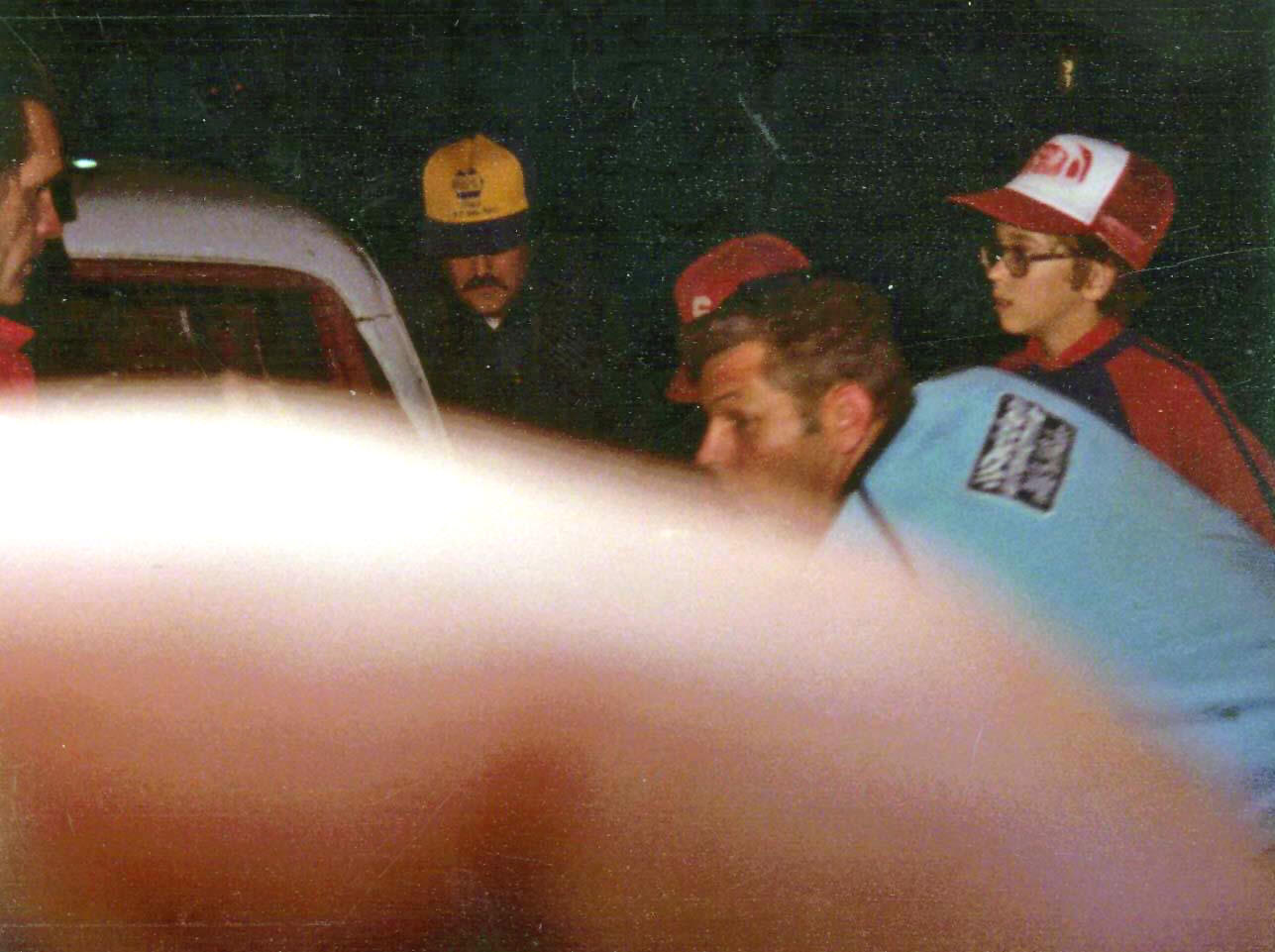
Ladabouche Photo
Wayne Hazlett looks in, to Butch
Elms to find out what Elms has pitted in the middle of leading a feature at Bear
Ridge Speedway.
Back in the 1980's, Bear Ridge Speedway was still being run by C.V.Elms, the elder, known as Chuck. His son, Butch was one of the track's best drivers. Butch was driving a coupe [ a very competitive one, at that] even though a few guys like Frank Keene and Bob Shepard were running Gremlins. Elms would eventually switch over to a state - of - the - art chassis, such as a Troyer or Olsen; and, before too much longer, he would be promoting and running the speedway by himself.
On this particular night, I had called ahead for press credentials, then writing for Speedway Scene. I loved the place, and I was treated very well by everybody. I took a few poor photos that night, and this one - while spoiled by some guy'g bald head - was still compelling.
_____________________________________________________________________________________________________________________________________
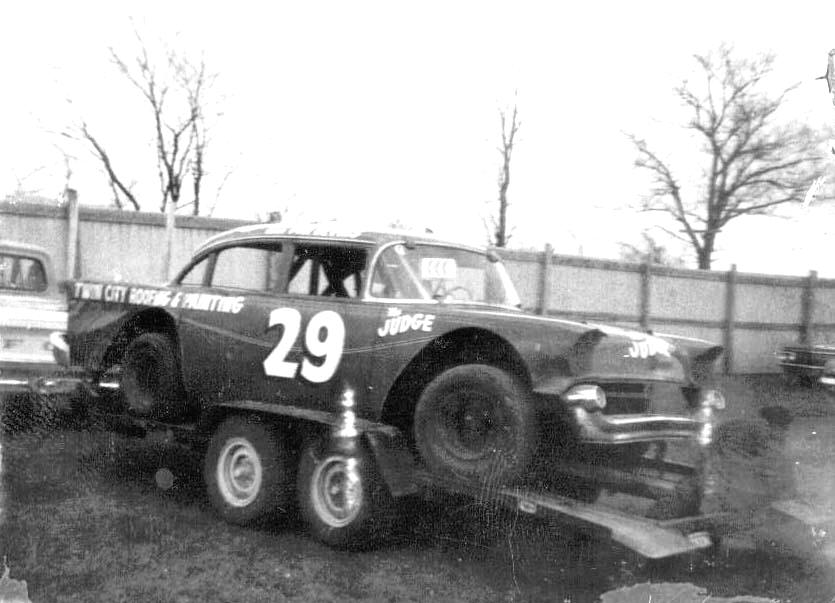
Ladabouche Photo
Don Bevins never had anything but a well
-appearing race car. This one, his first, sits in the pits at Catamount around
1970 or 71.
Right around 1970, one of the custodians at my school in MIlton, VT. was always telling me about his son - in - law, who was building a race car for Catamount Stadium. Catamount was coming back into its prime after an unpopular decision to eliminate the modified coupes had cost it some support in 1968. The potential for receiving bullshit stories was great, and I didn't pay much heed to what Tracy was saying until I saw this really sharp - looking 1957 Chevy limited sportsman parked by his house, about two doors from the school.
Don Bevins was the son - in - law. He eventually turned the Chevy over to his younger brother, Gary and he - along with local salvage yard operator Gil Rhoades, built the most gorgeous dark purple 1964 Dodge late model sportsman you would ever hope to see. Bevins proudly agreed to bring the car to my school when my students were having a late spring model show there. It made the Burlington Free Press and was a huge hit.
Bevins would win one or two features with that Dodge [ironically, the first win was with the entire front sheet metal missing from the car like a modified. He would later develop a close association with Jean - Paul Cabana and end up driving two Cabana - built cars. The first, an unusual '64 Chevelle, would end up going through four car owners and would carry Bob Ellis to a very prestigious 1973 NOrthern NASCAR Rookie of the Year award. The car above appeared as #9 for Gary before he built his own Chevelle.
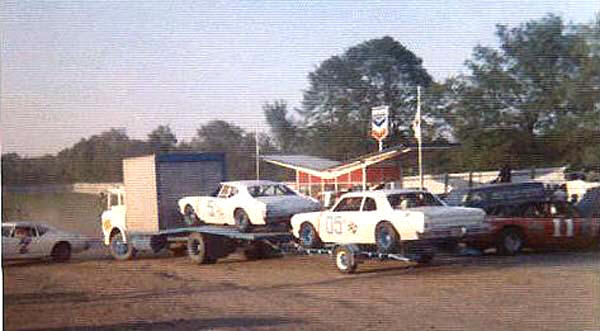
Ladabouche Photo
Cabana hauls in his Chevelle with the one he
had built for Bevins behind. This is the one that went through Cabana and
Bevins, Jack Dubrul, Austin Dickerman,
and ultimately Ray Richards [for Bob Ellis]. Few, except Cabana built Chevelles
with that body style with the roof post. His onw car had one, and the #7
passing by
[Ronnie Bettis] was Cabana's old car and it had a post as well. JP
told me why he did that, but I forget.
_____________________________________________________________________________________________________________________________________
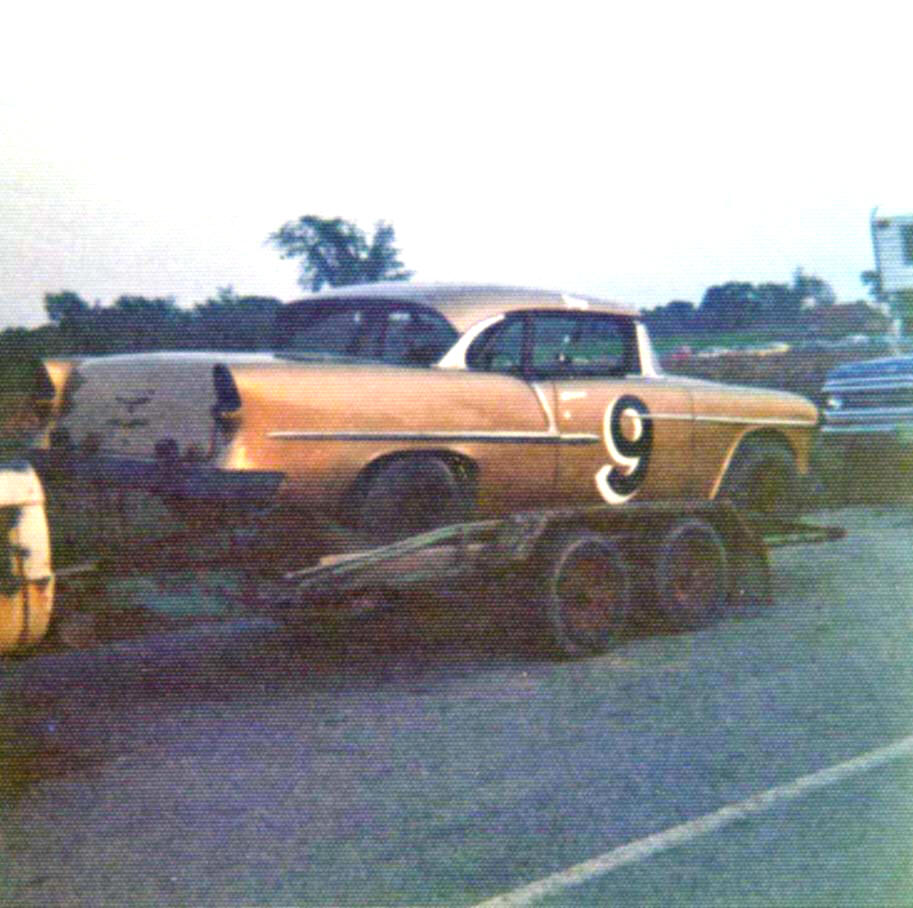
Ladabouche Photo
This shot goes
under the "live and learn" category. In 1971, I was just beginning my sign
painting career. This car, actually a Hurricane that looked more like a limited
sportsman, was about my fifth job ever. The little weasel who had this car, a
friend of the above Bevins family, never paid me despite continual flowery
promises.
_____________________________________________________________________________________________________________________________________
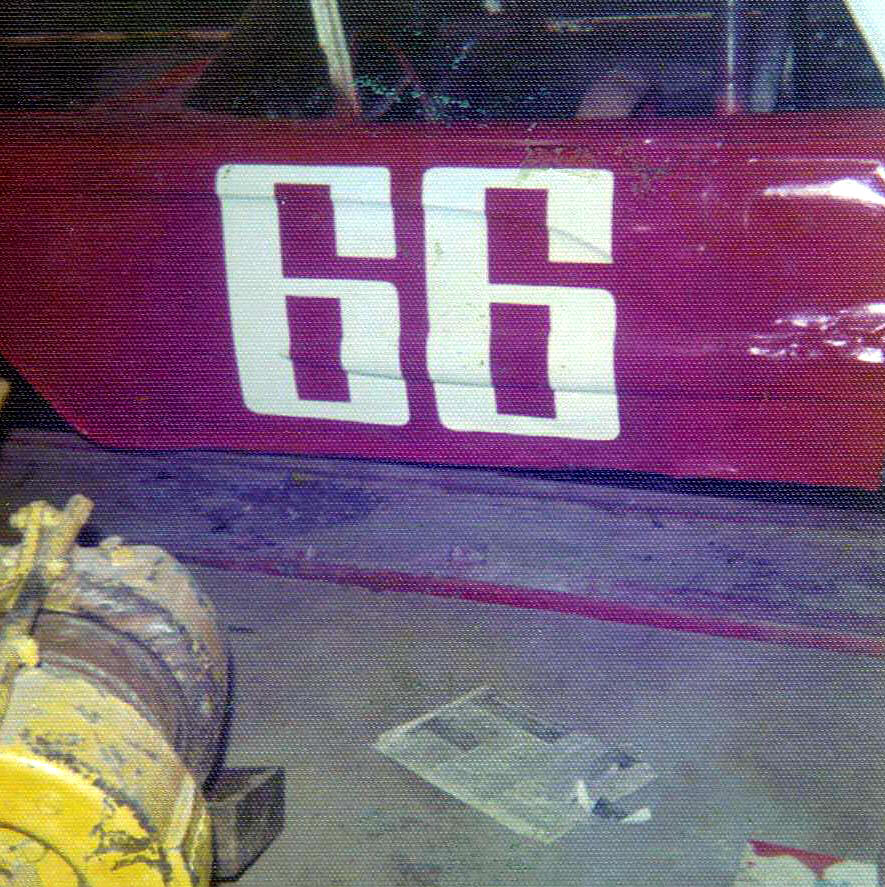
Ladabouche Photo
Again in 1971, I
was just beginning my sign painting business. My good friend Don Turner had
purchased the legendary Norm Cyr
Hurricane Division T - BIrd that had won almost every single race the first year
of that class. He bought it for radio personality, Ernie Farrar.
I had actually lettered
the Norm Cyr Thunderbird as what was officially my FIRST stock car sign job in
1970. I had no idea what I was doing and it was a real hatchet job; but I was
proud of it. Later, a neighbor [and a real sign man] took pity on me and showed
me real sign brushes and some technique. The above red 66 was the first job done
with those brushes around 1972. I still have many of the brushes, although I
haven't painted since 1983.
Farrar never really did much driving with the car. Turner
went on to get a better Hurricane car and had some fun for aseason or two. Cyr
recently told me the secret of his success with that first Hurricane. The
Thunderbird had a passing gear that allowed it to be driven in that gear for
long periods of time - which gave the experienced Cyr a real leg up on the
competition [mostly lumbering behemoths of cars with no handling].
Cyr later tried killing himself in an ill - handling Chevelle before handing off the family driving reins to well - known son, Jean - Paul. Turner would finish up racing with the Dodge Hurricane that launched the career of Leon Gonyo. He would pass it on to son, Don, Jr. who has become better known as a poiitician in Montpelier. I went on to letter dozens of stock cars for Catamount. Farrar, who still appears daily on talk radio, never drove again.
Ladabouche Photo
I eventually got better with the sign
brushes and was once entrusted to restore the Catamount sign. My kids are in the
back, holding it up as they often did.
_____________________________________________________________________________________________________________________________________

Ladabouche Photo
Louie Senecal's Plymouth is shown here, in
1963, in double exposure. I had taken hundreds of photos - but I screwed up this
one. Bad karma !
When I was a junior
in high school and going to the races at Fairmont Speedway, one of my Proctor
neighbors, Louie Senecal,built this six cylinder 1954 Plymouth to try at the
track's hobby division.
I had recently reached the realization that I
was fascinated as much by the numbers on a well - graphicked race car as by the
speed and noise. Not even knowing the guy, I somehow wheedled my way into doing
some of the lettering. Then I messed up my crowning moment by double exposing
the photo.
Senecal knew right off a sputtering six
banger running in with some sweetly tuned 283 V-8's wasn't going to work. He
sold the car off to my friend Bob Allard who was going to put a tiny little man
aptly named Clarence Short in as driver. We had changed the car to #16, but it
never made it into an actual race. Louie would go on to a pretty good late model
career at Devil's Bowl. Bob and I would go to races for several more years.
Senecal would go on to briefly promote - at
the old site of the Otter Creek Speedway. He called it Rainbow Ridge Raceway,
but had no luck. C.J. Richards, then running his Devil's Bowl on pavement,
thought Senecal might do OK with a nearby dirt track and even backed him- but to
no avail. I would do one more race car - for Charlie McMahan - before I was
pretty much engulfed in the life at Castleton State College. As mentioned, I did
a lot more sign painting about six years later.
_____________________________________________________________________________________________________________________________________
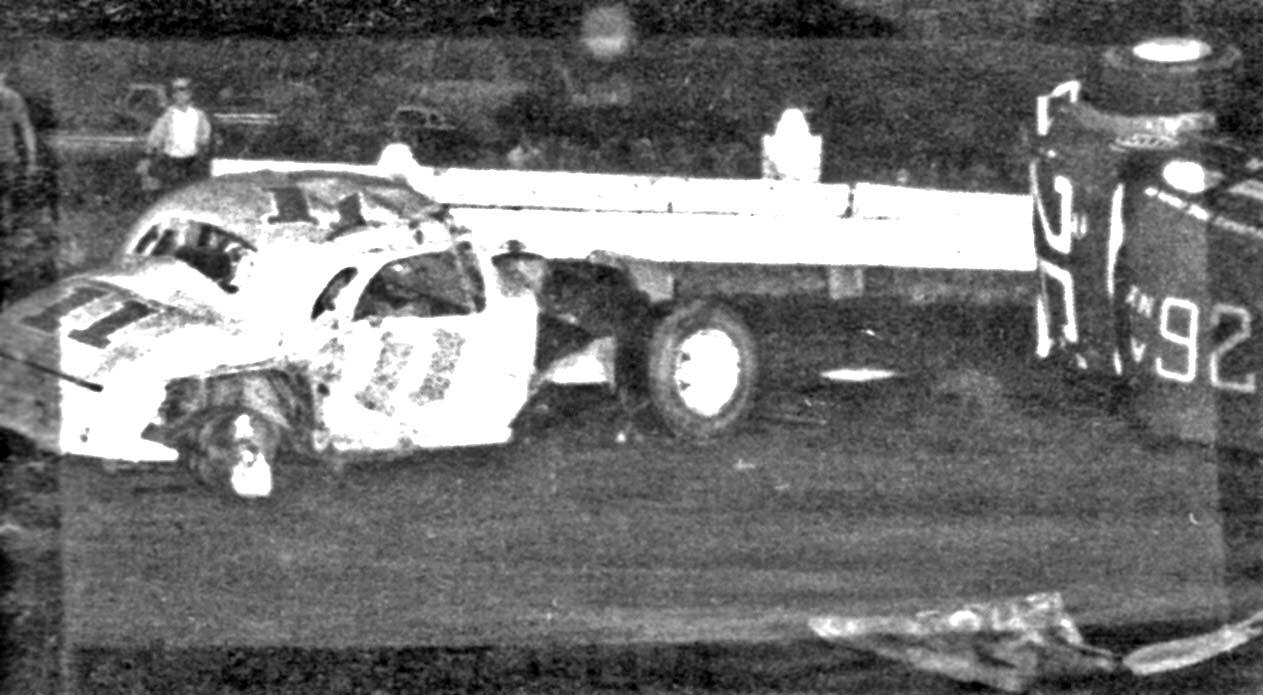
Gater Racing News - Ladabouche Collection
Jim Koehler's tan #11CT sits, wrecked on the
Fonda Speedway straightaway. He obviously connected with Phil Becker's 26NY.
When I was a freshman in high school, a long
drought of seeing stock car races ended when my uncle and I learned of a track
that had opened near Vergennes, VT. It was Otter Creek Speedway and was the
first version of that same track Louie Senecal tried promoting almost ten years
later. The track, being NASCAR, featured a few pretty good sportsman coupes -
all there looking for easy national points. One of the sportsman drivers whose
name was unfamiliar to me was one Jim Koehler, from Coventry, CT.
Koehler had this brown #31 CT, and appeared to be
somewhat competitive with the bigger stars like Ken Shoemaker and Dick
Nephew. The next time I saw that car was at Fonda, the following year, when my
uncle and I began infrequent pilgrimages to the Track of Champions. Koehler
would also appear at our local track, Fairmont Speedway, which opened the year
after Otter Creek did - 1962.
As time went on, Koehler would re-appear at
Fairmont in various other cars, culminating in 1965 with a very spiffy,
apparently - new tan #11 CT. Koehler, now a Saturday night regular at Fairmont
would take the car to Fonda in 1966 and mange to wreck it badly enough to ruin
his season. He would eventually become friends with the McMahans [Charlie and
Dave] and garage the car with them until Dave bought it and ran it at Devil's
Bowl around 1967 or 68.
A tall, blonde guy, Koehler always struck
me as somewhat of a loose cannon, appearing in and out of tracks with his ever -
present mechanic nicknamed Orchid. His l;ast car was a #9CT at Devil's Bowl. He
had some effect on several local Rutalnd area teams, teaching them the Felmeke
front end setup and other little tricks of the trade b efore disappearing back
to Connecticut.
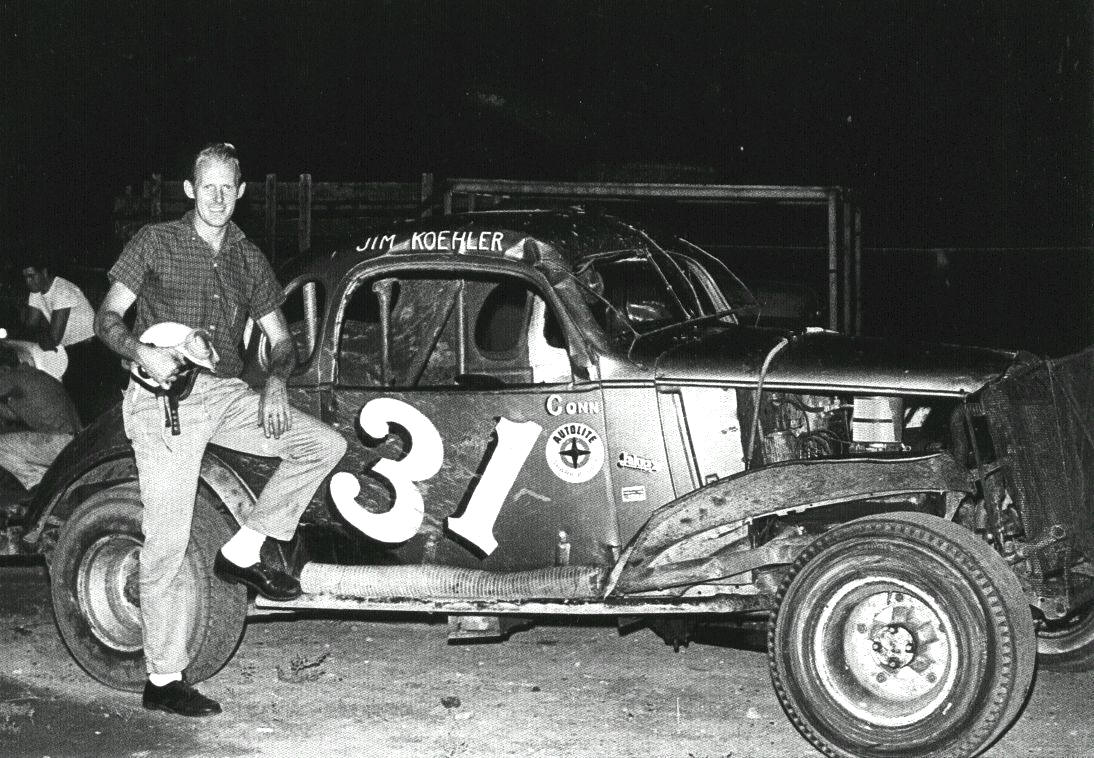
Courtesy of Bob Novak
Long tall Jimmy Koehler and that first
sportsman coupe - at Victoria Speedway.
_____________________________________________________________________________________________________________________________________
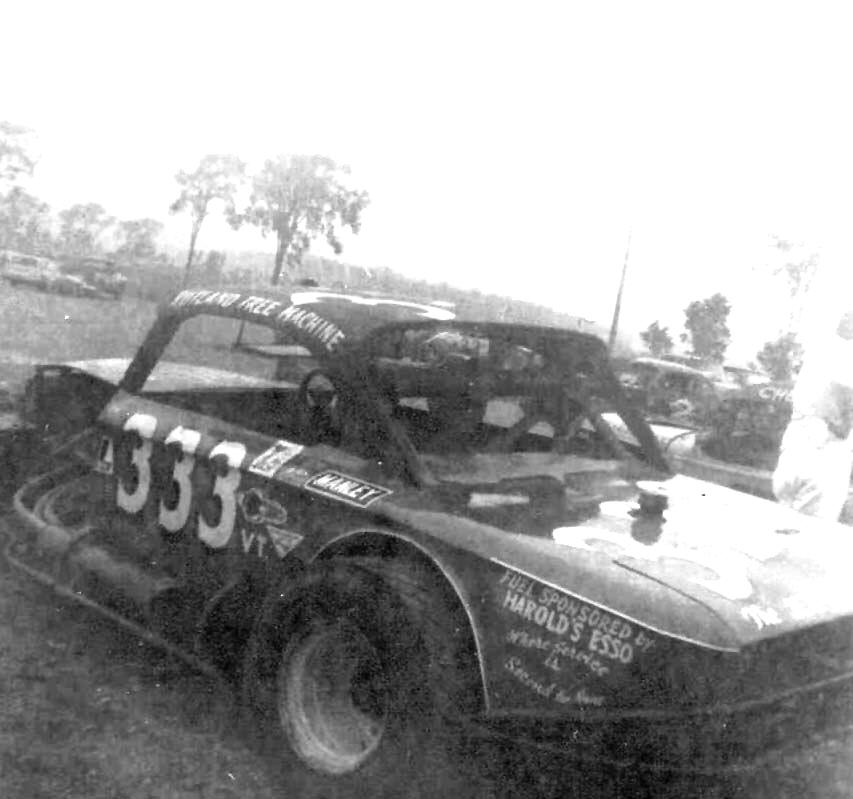
Ladabouche Photo
The Leo Vallaincourt - owned 333
Corvair, at Devil's Bowl around 1968. Sonny Rabideau was the driver at the time.
Leo Vallaincourt and the Rutland Tree Service team had come onto the scene at
Fairmont Speedway around 1964. Sporting a car that was obviously of Claremont
Speedway lineage and a driver named Howard Stevens who had been a a Claremont
driver, the team seemed to be from Rutland in name alone. The orange early '30's
flathead coupe with its neat homemade numbers caught my attention, while the
team and driver turned out to be extremely personable to a pain - in - the - ass
teenage kid who wanted to hang around them.
The following year, as Fairmont went over to the
overhead V-8 sportsman car, the 333 came back with an overhead of its own and
snappy professioinal lettering. Stevens was one fo the best cars there. Although
now in college, I came up with an orange golf shirt like the teams' members had
and had my mother do the same 333 on the back with my name on the front. I got
to "help" every Saturday night. With Stevens leading the points race in
midsummer, Vallaincourt sold the car out from under us - to Sonny Rabideau, a
Claremont - based superstar.
I didn't get to as many races after that, with
the demands [beer, girls, studies, beer] of college. When I took a trip over to
Devil's Bowl, two years later, I into the pits and saw an orange #333 with the
more modern Corvair body. I reached through the links of the fence and took the
best photo I could. Most of the crew was new and took n notice of me, so I moved
on to become a Wes Moody fan.
Rabideau and Vallaincourt teamed up for several
more tries and a few more cars before packing it in. Rabideau still had some
good years at Claremont, as well.
Ladabouche Collection
Cavalcade of Auto Racing
Leo Vallaincourt with his
Falcon - either at the last season of Fairmont or the first at Devil's Bowl.
Same shirt we all had.
_____________________________________________________________________________________________________________________________________
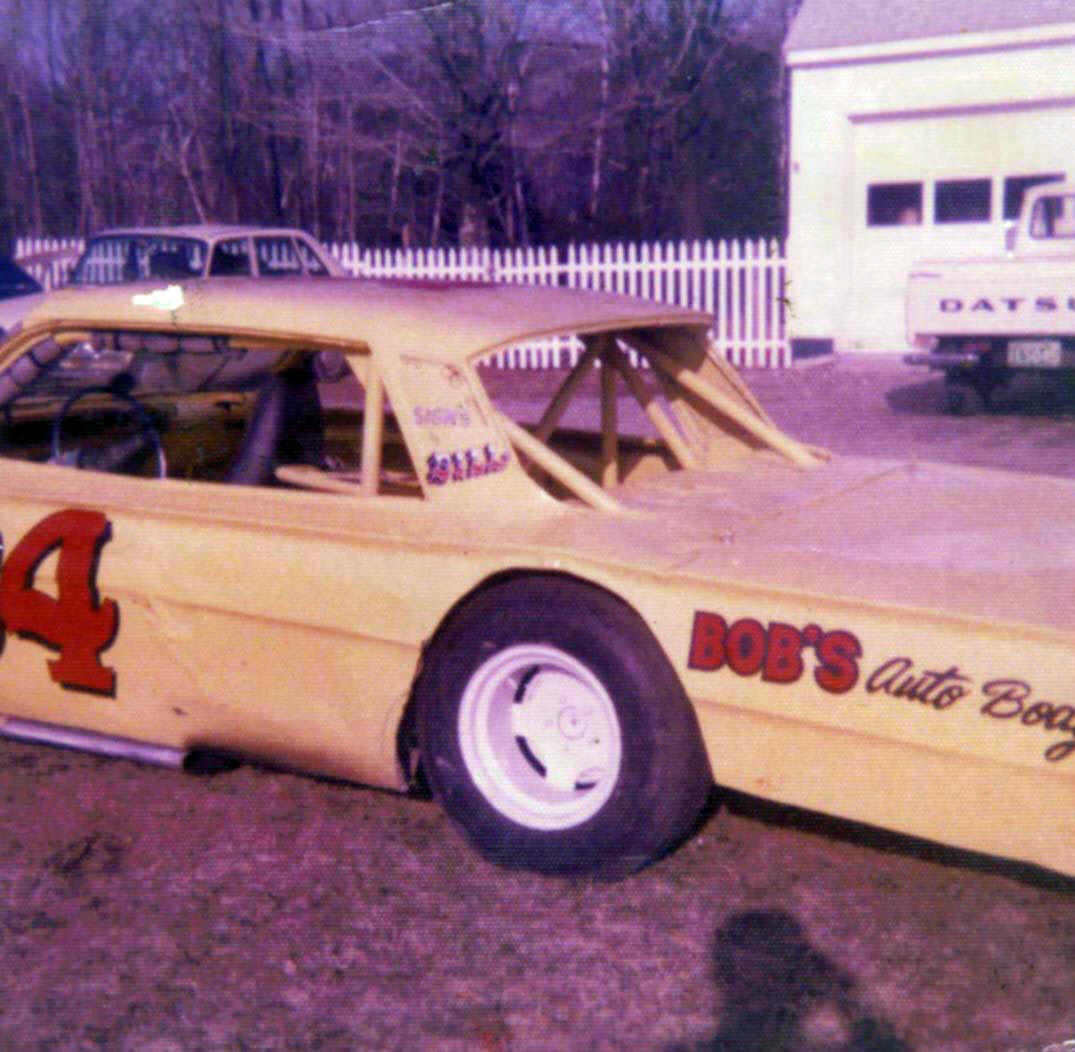
Ladabouche Photo
Brad Wright's giant '62 Chevy
Hurricane sits in my yard after being lettered. There's my unusual little
Renault 16 in the background and my Datsun sign truck.
The Hurricane Division began in 1970 at Catamount as the Night Riders, a name
that lasted all of a week. Soon, the automatic transmission class had begu nto
evolve into reasonably - handling race cars, once the guys got rid of the huge
Buicks and Oldsmobiles in favor of smaller cars. The first good Hurricanes ended
up being sold to new drivers by 1972 or 3 and one of these was Brad Wright. A
tall, gnagly blonde huckleberry finn type of guy, Wright was one of the large
contingent from Burlington's North End to race in the early 1970's. While fellow
North Ender Buzzy Lambert turned out to be the best of the crop, Wright made his
money years later with a boat dealership. He was always a riot - quick with a
one - liner.
The Hurricanes would morph into six cylinder Grand
American cars, and the combined classes produced the likes of Larry Caron,
Richard Buzzi, Norm Andrews, Jamie Aube, and dozens of future stars. My
Hurricane customers gave the experience needed to go on to lettering the top
late model sportsman cars, as well as fire trucks, wooden signs, and the like.
Brad tried one more car after this before hanging up the helmet. This one worked
better for him.
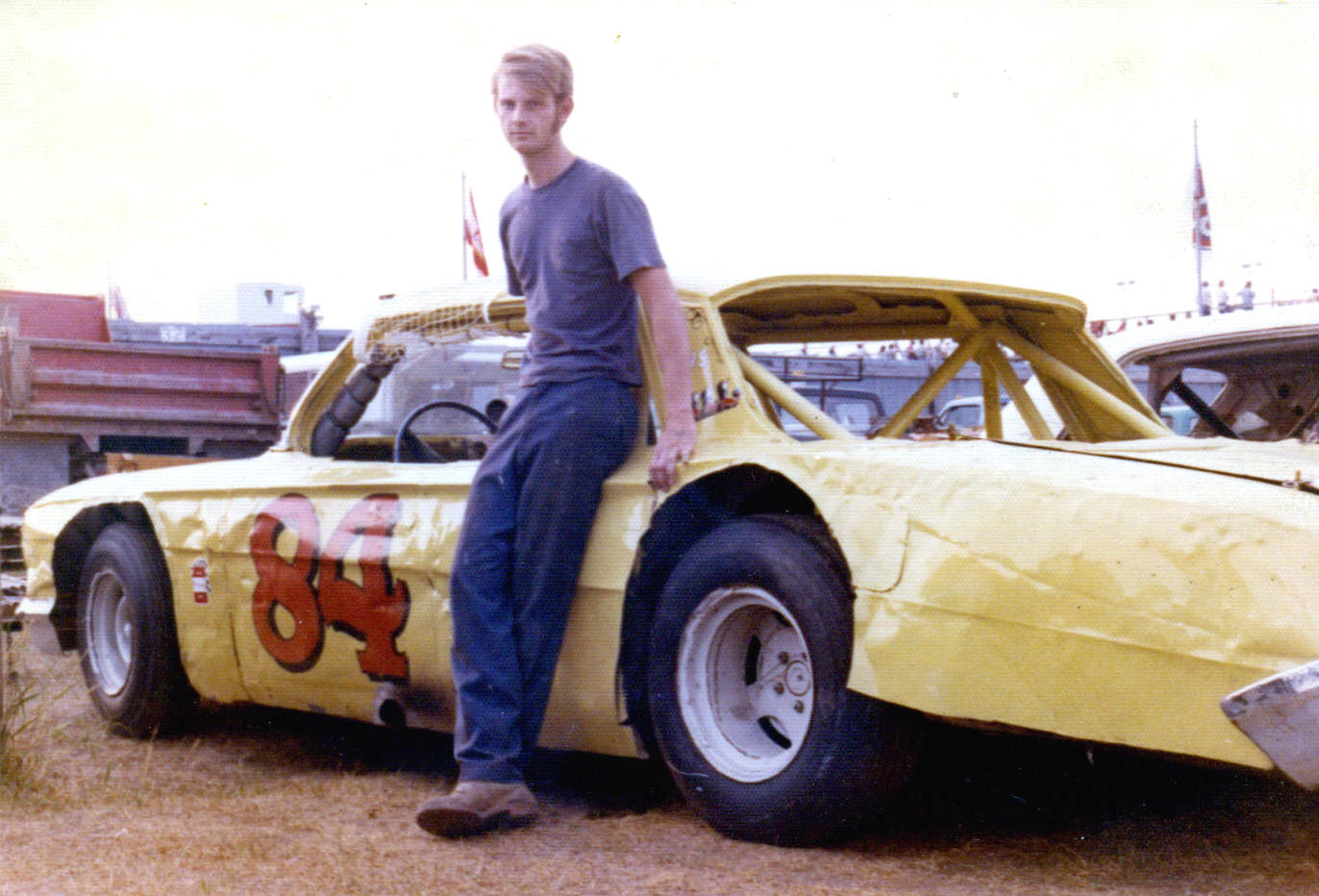
Courtesy of Steve Pecor
Brad and the first car - obviously second
hand as this was his first week with it.
_____________________________________________________________________________________________________________________________________
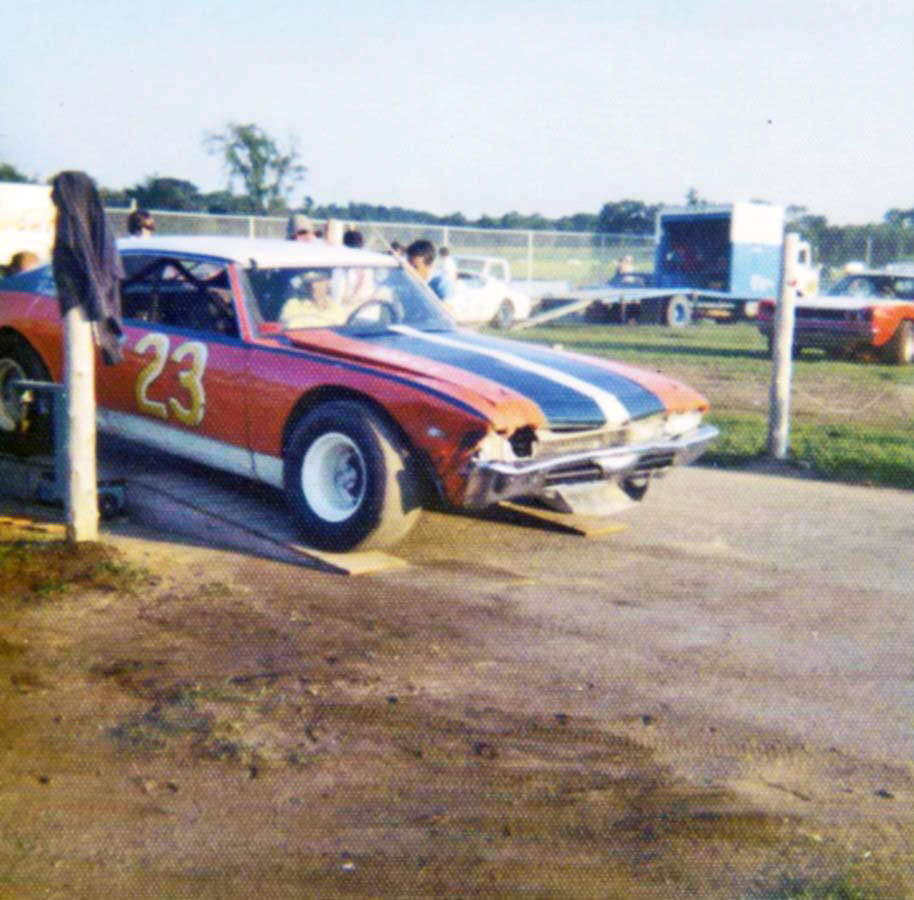
Ladabouche Photo
Massachusetts tire dealer and race car driver
Dave Lind drives the Virgil Rendl '68 Chevelle off the scales at Catamount
around 1973.
The early 1970's at Catamount meant the beginning of the late model sportsman
era. lasted all of a week. This soon attracted a large contingent of
Massachusetts NASCAR drivers to what appeared to be "the place" for this type of
racing in the Northeast. Among the Norwood Arena teams that came were the orange
and blue cars of Virgil Rend. Never a particularly high 0 running team, the 234
MA had driver Dave Lind in the '68 Chevelle and Rendl's brother - in - law,
George "Skip" May in the '64 Chevelle.
Lind would transfer over to his own blue Fairlane 500,
#41. May would seemingly disappear for years, returning in the New Flying Tigers
with an absolutely gorgeous Camaro. Skip would race for a few years in the New
Tigers before handing over the controls of family racing to George III, who
still runs Tigers at White Mountain from time to time. Eventually, most of the
Massachusetts teams had faded and returned to the Bay State, as racing costs
soared. But, names like Rosati, Kourafas, Ruggieri, Karvonen, Melnick, May, and
many more are etched in Catamount's history.
Courtesy of Skip
May
Skip wins one at Thunder Road with the old Rendl car.
Return to the Main Page
Return to the
Main News Page
Return
to the All Links Page